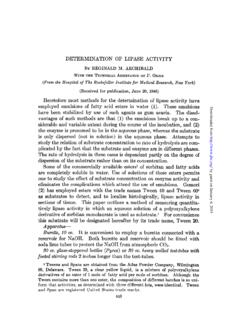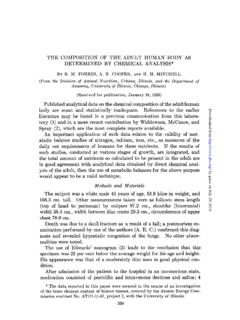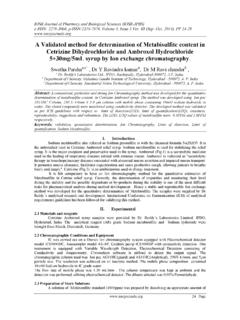Transcription of CITRIC ACID DETERMINATION - The Journal of …
1 CITRIC acid DETERMINATION BY AARON S. GOLDBERG AND ALICE R. BERNHEIM (From the Laboratory for the Study of Peripheral Vascular Diseases, Department of Surgery, the New York Hospital, and Cornell University Medical College, New York) (Received for publication, April 19, 1944) Three types of methods have been proposed for the DETERMINATION of CITRIC acid in urine. Salant and Wise (1) used the unspecific mercuric sulfate reagent of Deniges (2) in a study of the toxicity of citrates. Thun- berg (3) developed an enzymatic method employing a dehydrogenase said to be specific for citrate. The remaining methods depend on the so called pentabromoacetone method of Stahre (4), a qualitative test published in 1897 which Kunz (5), in 1914, used as the basis of the first quantitative pentabromoacetone method. It has been generally overlooked that in 1847 Cahours (6) prepared a bromination product from several citrates which he called bromoxaforme which according to his melting point and solubility data is without doubt identical with pentabromoacetone.
2 Cahours was aware of the specificity and analytical applicability of the reaction. ( Le brome peut done servir a reconnaftre de petites quantit& d acide citrique mhlangbes a l acide tartrique. ) Kunz s technique was adapted for use with urine by Amberg and McClure (7). Fasold (8) with this method was the first to isolate CITRIC acid from normal urine. Kometiani s (9) modification of this method was applied to urine by Stillmann and Schaerer (10). Pucher, Sherman, and Vickery (11) de- veloped a spectrophotometric method based on the color formed when pentabromoacetone is treated with sodium sulfide. Our procedure is another modification of this method. It is precise, accurate, and time- saving. The pentabromoacetone reaction has been clarified and new reagents with certain advantages have been introduced. While the procedure was designed for 15 cc.
3 Samples of urine, it is also applicable to 2 cc. samples, as well as to other fluids of comparable citrate content. The range is from 1 to 40 mg., although with care, useful results are ob- tainable down to mg. The method has already been used in a study of the variation of urinary citrate with the menstrual cycle (12). Principle The CITRIC acid is oxidized by manganese dioxide, in the presence of bromine, to acetonedicarboxylic acid , which is then rapidly brominated with simultaneous decarboxylation, yielding pentabromoacetone. After reduction of the excess manganese dioxide and bromine with hydrazine, 33 by guest on November 20, 2019 from 34 CITRIC acid DETERMINATION the pentabromoacetone is isolated by with petroleum ether. It is then treated with a sulfite solution, which we find destroys penta- bromoacetone smoothly and rapidly, liberating all 5 bromine atoms as bromide ions.
4 The bromide is determined by a direct argentometric titration. Reagents- 27 N sulfuric acid . 1500 cc. of concentrated acid , diluted to 2 liters. 2 N bromide-bromate. gm. of NaBr and 28 gm. of NaBrOQ (11 per cent excess) are dissolved and diluted to 500 cc. 2 N silver nitrate. gm. dissolved and diluted to 250 cc. 10 x hydrazine. gm. of N2H,.HzS04 are dissolved with the aid of 49 cc. of 20 per cent NaOH or the equivalent and diluted to 100 cc. 2 M manganese sulfate. gm. of MnS04 .4Hz0 dissolved and diluted to 250 cc. M KMnOe. gm. dissolved and diluted to 1 liter. Petroleum ether ( 35-60 ). Preferably purified by shaking several times with concentrated sulfuric acid and distilling. A small forerun and residue are discarded. per cent aqueous methylene blue solution. Sulfite reagent. gm. of NaHS03 (halogen-free, for microanalysis) are dissolved in water and somewhat less than 40 cc.
5 Of clean 20 per cent NaOH or the equivalent, and 50 cc. of alcohol added. Dilute to 500 cc. after checking the pH, which should be to If the pH is lower, add alkali as necessary. Keep in the refrigerator in several small bottles filled to the brim. 18 N HzS04. 100 cc. of concentrated sulfuric acid diluted to 200 cc. 25 per cent ferric alum. 50 gm. of FeNH4(S0&. 12 HzO are dissolved with the addition of 7 cc. of 27 N H&S04 and diluted to 200 cc. N KCNS. Diluted from a suitable stock solution. Exactly N silver nitrate. gm. of pure silver nitrate are dissolved, 130 cc. of nitric acid added, and the solution diluted to 2 liters. Procedure Urine-A 24 hour specimen is collected and 25 cc. of 27 N sulfuric acid are added as a preservative. Preliminary Brominution and Clarijication-25 or 30 cc. of urine are placed in a 50 cc.)
6 Volumetric flask, followed by 10 cc. of 27 N sulfuric acid and 2 cc. of bromide-bromate mixture. The flask is set aside in the dark for 10 minutes, at room temperature, then 2 cc. of 2 N silver nitrate are added, and the flask well shaken. The residual bromine is discharged by the minimum of solid metabisulfite or other sulfite preparation, and the solution is made to volume. If necessary, a fraction of a drop of by guest on November 20, 2019 from A. S. GOLDBERG AND A. R. BERNHEIM 35 octyl alcohol may be used. The flask is shaken vigorously and t,he con- tents filtered into a dry 1 25 cc. separatory funnel. The filtrate is shaken for 3 minutes with 10 cc. of petroleum ether and a 25 cc. aliquot transferred to a 60 cc. separatory funnel to which are also added 1 cc. of the manganese sulfate reagent and 1 cc. of bromide-bromate mixture.
7 Oxidation to Pentabrowwacetone-Permanganate is now added dropwise from a pipette with a tip drawn out to deliver about 60 drops per cc., with constant swirling to avoid local excess, until the orange color of the bromine is replaced by a brown color (about 1 to 3 cc.). If at this point, depending upon the other substances in the solution, the color deepens and a slight precipitate of manganese dioxide slowly appears, or if the color becomes lighter, more permanganate is added. The funnel is al- lowed to stand for 20 minutes, when hydrazine is added dropwise to reduce the manganese dioxide and bromine (about 6 drops). The colorless fluid is shaken for 3 minutes with 10 cc. of petroleum ether and the aqueous phase is discarded. The stopper, mouth, and walls of the funnel are washed twice with a jet of water from a wash bottle and the washings discarded.
8 20 cc. of water are added, the funnel is shaken for about 20 seconds, and the water discarded without first swirling the funnel. This allows a small amount of insoluble, slimy material (usual in urine) to be deposited in a thin film on the walls of the funnel instead of collecting at the apex where it is more troublesome to handle. 1 or 2 cc. of methylene blue solution are allowed to flow around the walls of the funnel to permit easy observation of the interface. After a minute or two for drainage, the stem of the funnel is washed with water and the methylene blue layer very carefully drawn off until the petroleum ether enters and just fills the bore of the stop-cock. The water in the stem is sucked out by means of a capillary pipette and the petroleum ether is run into a 4 X 1 inch Pyrex test-tube. The funnel is washed twice with 1 cc.
9 Portions of petroleum ether, the washings being added to the tube. A tiny fragment of porcelain is placed in the tube and the solvent evaporated to about cc. The remainder of the solvent is allowed to evaporate at room temperature by holding the tube almost horizontally and rotating it so that the petroleum ether is spread over the bottom third in a thin film. This procedure prevents the loss of the somewhat volatile pentabromoacetone. Since evaporation of the petroleum ether must be conducted without * An alternative procedure is available from this point if preferred. 4 cc. of sulfite solution are placed in the funnel which is shaken for 3 to 5 minutes. The sulfite is then transferred to a 4 X 1 inch test-tube and the funnel washed three times with 1 cc. portions of added water. The tube is then immersed in a boiling water bath for 3 minutes, the 18 N sulfuric acid added, and the rest of the procedure followed as described below.
10 By guest on November 20, 2019 from 36 CITRIC acid DETERMINATION overheating because of the volatility of pentabromoacetone, we have devised for this purpose a heating spiral made from about 6 cm. of nichrome wire cut from a standard replacement unit, which with the rest of the unit has the appropriate resistance for use with a 110 volt source. The heater uses about 6 watts with an evaporation time of about 7 minutes. Decomposition of Pentabromoacetone-The wall of the tube is carefully washed with 2 cc. of alcohol, and 4 cc. of the sulfite solution are added immediately with mixing. The tube is immersed in a boiling water bath and 3 minutes later 1 cc. of 18 N sulfuric acid is added cautiously, the tube is removed, and its contents are boiled over a free flame for a few seconds to expel sulfur dioxide. cc. of ferric alum are added and the solution is boiled for a few more seconds and cooled, when 1 cc.











